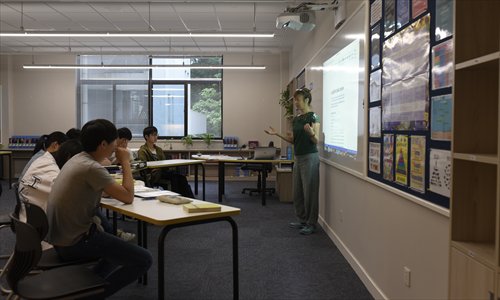Affordable international schools make their way into second- and third-tier cities

Students gain equal access to international education resources in second- and third-tier cities with the introduction of international schools. Photo: IC
When Helen Zhou and her 13-year-old son Tiantian first arrived at Chenshan School in Huangshan, Anhui Province in 2014, they were impressed by the boarding school's campus, located in a scenic resort by beautiful hills in Xiuning, a county in Huangshan.
Zhou, who works in IT industry in Beijing, embarked on the tour in a bid to search for an ideal international middle school for Tiantian. She had done research and compared international schools in Beijing, but none stood out to her and Tiantian as much as Chenshan did.
"Among the draws of Chenshan are the teaching faculty dedicated to offering International Baccalaureate (IB) courses (an education program recognized worldwide for its rigor and innovation), the strong background of the school investor and its valuable learning and living environment so close to nature," explained Zhou.
"The international education resources were still scarce [in China] in 2014," she added.
Over the past two years, an international education boom has started in China responding to the rising demand of middle- and upper-class urban families' desire to access foreign education resources. While a growing number of schools and programs boasting international education are available in first tier cities, such as Beijing, Shanghai and Guangzhou in Guangdong Province, Chenshan is one of the players pioneered to establish campuses in second- and third-tier cities.
According to a May report in Future, a magazine focused on overseas education, more than 15 schools offering international education are slated to open within the year in second- and third-tier cities, such as Yantai in Shandong Province, Shaoxing in Zhejiang Province and Lanzhou in Gansu Province.

A teacher from Australia leads students in an English language class at Chenshan School. Photo: Courtesy of Helen Zhou
Go to small cities
When the semester started in autumn of 2014, Tiantian became the first group of more than 20 students to study at the new school. The cost of quality education does not come cheap; tuition fees for the school were 80,000 yuan ($11,970) per semester. However, the school's ambition to grow was soon crippled after funds from the investor were withdrawn following a school management crisis.
Operating an international school in China's second- and third-tier cities poses greater challenges than school founders and investors initially imaged. "The local demand for international education resources is smaller because the local's education ideology and financial strength are not comparable to those in first-tier cities," said Zhou.
But Zhou and other parents, who trusted Chenshan's education quality and wanted their children to continue to study at the school, decided to retain it from being shutdown. After negotiation with the school, Zhou took over Chenshan and became an investor and the Board Chair in 2015.
The challenges
In an article in 21 Century Business Herald in September 2015, Ma Cheng, the deputy director of Tsinghua International School in Beijing, summarized the factors leading to the predicament of international schools in China's second- and third-tier cities.
"It can be difficult for international schools to recruit students in second- and third-tier cities, even in areas where foreign investments are concentrated and Chinese companies hire foreign employees," said Ma. "It is common that children of [the foreigners] were sent to study at schools in Beijing and Shanghai, while parents are on the run to second- and third-tier cities to work."
However, Ma addressed that international schools are in demand in these cities.
He said China needs to build more cities with international culture and environments across the country as China continues to develop. The lack of international education would make the city less competitive. Meanwhile, international schools will help offer opportunities to students in second- and third-tier cities, providing them with equal access to international education resources.
The branch campus
A couple of days ago, the first admission letter of Kunming World Youth Academy (KWYA) in Southwest China's Yunnan Province, was delivered to one of its young applicants. A branch school of Beijing World Youth Academy (BWYA), a Chinese private school offering an international education to students of all nationalities, is set to be in operation starting this September.
Li Meng, the resident director of BWYA training center, is among the school's staff that often travel to Kunming to assist in the school's start-up phase. From his perspective, it's an inevitable trend that more international schools will open in China's second- and third-tier cities. "More than 50 schools offering international education programs are set to open in 2016, most of which are located in second- and third-tier cities."
One of the reasons leading BWYA to open a branch school in Kunming, according to Li, comes from the great support of local government, who see the work of introducing and establishing international schools as a key piece for city development.
For the upcoming semester, KWYA will be teaching grades 6, 7, 9 and 10, with a plan to admit 80 new students. In 2019, primary school education will be added to the school.
"After speaking with parents, we saw a clear demand for international education for younger students in cities like Kunming," said Li.
As a boarding school, KWYA mainly targets Chinese students from regions in and around Yunnan, said Li. "Recruiting foreign students will be our next step in development. Responding to China's One Belt and One Road initiative, we hope to attract more students from Association of Southeast Asian Nations to the school to attain world-level international education."
International programs
Apart from the expansion of international schools, international education programs that pair with local schools in the second- and third-tier cities, present a more affordable choice.
One such program is BELA International Education, which offers a high school program that incorporates American high school systems. It involves two years' study at BELA schools in China and one year of study in public schools or universities in the US that work with BELA. Besides first-tier cities, such as Beijing and Guangzhou, BELA has been running schools in Guiyang in Guizhou Province, Foshan in Guangdong Province and Taicang in Jiangsu Province.
"The student resources in second- and third-tier cities vary in accordance with regional economy development, the quality of local schools cooperating with BELA and the local awareness and prevalence of international education," said Li Song, president of Beijing BELA Education and Technology.
"In general, parents of BELA students have high incomes, are well educated and have the experience of studying and living overseas," said Li Song. "They tend to resist China's gaokao system and expect their children to go to a university with world prestige. Having the ability to study in a more relaxed environment allows students to gain skills and knowledge that prepare them for future competitions."
"BELA's tuition fees are 50 percent cheaper than private schools," said Li Song. "Students from middle-income families are starting to join the school. There is space for international education to grow in second- and third-tier cities," he said, adding that BELA will continue to expand into more cities.
Hard to recruit foreign talents?
Both Zhou and Li Meng said that recruiting good, qualified teaching professionals won't pose a problem for their schools.
"We recruit professionals through international channels, bringing teachers to China directly from international job markets, including those in Thailand, the UK and the US," said Zhou. "Some of the teachers have already taught in China."
Despite the fact that Kunming is less developed compared with first-tier cities, the lower living cost, better air quality, natural beauty and the fame of the international schools, are among the assets that will draw foreign professionals to the school, said Li Meng.
Currently, Chenshan only has seven students who come from Beijing, Shanghai, Zhejiang and Jiangsu provinces. Since taking over the school, Zhou's team has completed reconstructing the curriculum system - while keeping its mature IB education courses, it includes a Chinese teaching team specialized in Chinese education to provide a higher quality of traditional Chinese culture education to the students.
Meanwhile, Chenshan is undergoing an authorization process to be an IB World School. The bilingual course department has been added to the school structure with an aim to better meet the local education demand.
"We are also planning to start cooperation with foreign schools to offer student exchange programs," said Zhou.
"Tuition fees in China's international schools are quite high and we want to make sure the parents are receiving the most for what they are paying."
Newspaper headline: Education for all